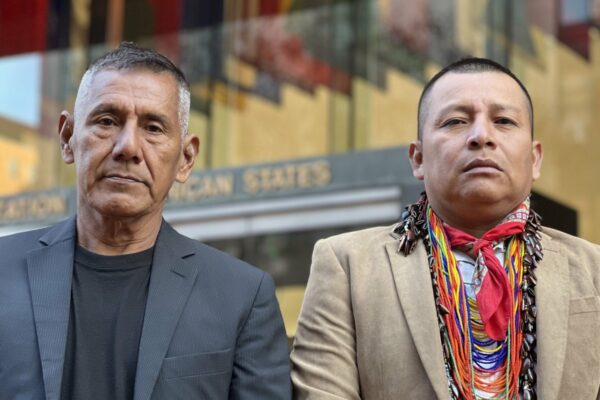Saravena, Colombia – On the edge of the war-torn city of Saravena, U.S. military advisers are preparing for a major escalation of American involvement in Colombia’s 38-year-old civil war.
Until now, U.S. military and economic assistance to Colombia has gone largely to fight the drug war. But in January, between 60 and 100 U.S. Special Forces soldiers will arrive in Saravena and the surrounding area to train thousands of Colombian troops to protect a 500-mile pipeline owned in part by Occidental Petroleum Corp. of Los Angeles.
Their arrival will mark the United States’ first close involvement in a bloody and complex conflict waged between and among two leftist insurgent groups, a right-wing paramilitary force and the outnumbered Colombian
military.
At Saravena’s military base, four U.S. advisers are constructing 10 helicopter pads and fortifying barracks that will house the Special Forces troops.
Sandbags stacked 6 feet high ring the barracks. Sandbags are piled on the roofs, too, so that homemade rebel rockets made of gas canisters would roll off the barracks before exploding.
“This is one of the most difficult regions in Colombia relative to threat but we understand what we are getting ourselves into,” said Wade Chapple, one of the four U.S. advisers. “We know who is who and we do our best to
minimize our vulnerability.”
The battle over the pipeline, which winds through northern Colombia carrying 120,000 barrels of oil a day, has lasted the better part of 15 years. The pipeline is a key source of revenue for both the leftist insurgents and the
Colombian government.
Since 1986 the pipeline has been bombed 950 times by leftist rebels, shutting it down for months on end and costing the cash-starved Colombian government $2.5 billion in lost revenues.
The rebels, who view the pipeline as a symbol of U.S. imperialism, have used the attacks to extort hundreds of millions of dollars from local businesses and others.
The Colombian government, after years of inaction, is trying to wrest back control. For that, according to recently elected President Alvaro Uribe, Colombia needs the expertise and weaponry of the U.S. military.
The dramatic shift in U.S. policy faced opposition from some lawmakers, human-rights workers and others who fear U.S. troops could get bogged down in an interminable war where the insurgents fight with car bombs, homemade
rockets and assassinations.
Another concern is that the U.S. advisers will be working closely with a Colombian military that long has been accused of human-rights violations. Some critics also say the plan forces American taxpayers to foot the bill
for the security of a private oil company.
The Bush administration won congressional approval in July for the first part of a proposed $104 million pipeline-protection package by arguing that Colombia’s fight against leftist rebels is part of the United States’ global battle against terrorism. The State Department has labeled all three of Colombia’s insurgent groups “terrorist” organizations.
Protecting Colombian oil also fits into the long-standing goal of reducing U.S. dependence on Middle East oil, especially in light of possible military action against Iraq. Colombia is the ninth-largest supplier of imported oil
to the United States.
“The United States receives 3 percent of its [oil] needs from Colombia,” said Anne Patterson, the U.S. ambassador to Colombia. “That’s not much. But with problems in other countries each percentage is important.”
The pipeline runs through miles of guerrilla-held territory, along the porous Venezuelan border and up steep, inaccessible mountains before emptying at the Caribbean coast. Most guerrilla attacks occur in a 50-mile stretch that passes near Saravena.
1st focus: Better intelligence
U.S. military planners are hoping first to improve Colombia’s intelligence capabilities. Then, with U.S.-supplied helicopters, better-trained counterinsurgency units could quickly engage the rebels, who up to now have
operated with relative impunity.
“That’s a long-term project,” said Chapple, a U.S. Army special operations officer. “The terrain is difficult and there are large distances that we cover. You can’t put soldiers [on the pipeline] every 5 feet. Lack of mobility is a concern.”
In Saravena, a ramshackle town located on a lush plain, officials and residents greet the plan for U.S. forces with a mixture of anguish and support.
Some say they are tired of the conflict and are ready to back Uribe’s get-tough policy. Others fear that the arrival of U.S military trainers, their helicopters and other equipment will only intensify a conflict that kills about 3,500 Colombians a year and has devastated the town.
“I am one of those people who think that more war will not solve anything,” said Saravena Mayor Jose Trinidad Sierra.
Already this year attacks by leftist rebels in Saravena have killed a half-dozen people and injured more than 50 others. Launching homemade rockets, the rebels have turned the downtown area into rubble, destroying the city hall, the city council building, the prosecutor’s office and many
other structures.
Craters from rocket attacks pockmark the town’s main plaza.
“My family prays for me,” said Omar Neiza, a 22-year-old Colombian police officer in Saravena. “What we hope for is to get shot in the leg or get sick so that we can get out of here.”
The pipeline, which transports oil from the giant 1.2 billion-barrel Cano Limon field, has been a magnet for Colombian insurgents since it was opened under a joint operating agreement between Occidental and Colombia’s
state-owned oil company, Ecopetrol.
For years, Saravena and the surrounding region were dominated by the National Liberation Army, or ELN, Colombia’s second-largest leftist rebel army. The ELN bombed the pipeline 40 or 50 times a year, enough to extort
protection money, known as vacunas, or vaccinations, out of oil contractors and other businesses.
The rebels also took over local governments and siphoned off millions of dollars in oil royalties that by law must be paid by Occidental to local municipal and state entities.
“The ELN maximized its racketeering operation,” explained one Occidental official in Colombia. “What they did is go after the big resources and that’s the royalties.”
The ELN’s dominance ended in 1997, when Colombia’s largest leftist insurgency, the 18,000-member Revolutionary Armed Forces of Colombia, or FARC, began battling for control of the pipeline.
The struggle peaked last year when the FARC bombed the pipeline 170 times and shut it down for more than 200 days – thus denying the ELN the revenue to fund its army.
Occidental’s profits eroded
The bombings also hurt the bottom line of Occidental, which gets about 6.5 percent of its world production from the Cano Limon field. The frequent shutdowns last year cost Colombia’s government an estimated $500 million in lost revenue, or roughly 2 percent of its budget.
“Occidental did lose money as a result of the pipeline being down, but those losses were dwarfed by the losses of the Colombian government,” said Larry Meriage, an Occidental spokesman in Los Angeles.
While Occidental and Ecopetrol have provided helicopters, food and other logistical support to the Colombian military, corporate executives met last year with then-President Andres Pastrana and Patterson, the U.S. ambassador, to persuade them to bolster pipeline protection.
Meriage said it was U.S. Embassy officials who took the lead in the pipeline protection effort in Washington, though he acknowledged that the decision to send U.S. military advisers to the region will help Occidental’s oil
operation in Colombia.
“Does the company benefit from more security in the area? Absolutely,” Meriage said.
Earlier this year, Colombia’s military shifted large numbers of troops to protect the pipeline – something that has helped reduce the number of rebel attacks to 32 this year.
The success has provided a badly needed boost to the security forces here while also sending a strong signal to U.S. officials that Colombia – while desperately needing U.S. military assistance – is prepared to do the actual fighting against the guerrillas.
“We don’t need [U.S.] troops to fight. It’s our fight,” said Colombian Vice President Fernando Santos. “We know that it is a fight that we have to win.”
But some human-rights workers say the Colombian army unit responsible for pipeline protection, the 18th Brigade, has aided the advance of right-wing paramilitary forces, who are battling the two leftist insurgencies for control of the region.
Known as the United Self-Defense Forces of Colombia, or AUC, the paramilitary squads are suspected of assassinating two local congressmen and are believed responsible for 70 percent of 420 political killings this year in nearby Arauca city, the state capital.
Paramilitaries move in too
In two public letters circulated in Arauca city, the AUC marked more than 100 prominent residents for death and vowed to cleanse the region of guerrillas and their supporters.
“We will begin with those persons who are most compromised and whom do not have any other alternative but death,” one letter said.
Gen. Carlos Lemus, commander of the 18th Brigade, which will be the focus of U.S. military efforts, denied links to the AUC and said his forces are fighting the two leftist insurgencies and the paramilitaries “with the same vigor.”
“For our troops there is no difference between the terrorist FARC, the terrorist ELN or the terrorist paramilitaries,” he said.
Lemus said he is confident the U.S. military assistance will make a difference in the battle to protect the pipeline. But a recent FARC car bombing near Saravena illustrated the challenge of fighting an enemy that strikes and flees, rarely offering a solid military target.
The blast, aimed at a caravan of trucks owned by the state oil company, killed one oil worker and injured another.
The Colombian military quickly scrambled a single helicopter to strafe the guerrilla bombers. But it had no helicopters or vehicles to ferry troops to the battlefield. Instead, dozens of Colombian soldiers loaded down with rifles, grenade launchers and other equipment trudged along an empty highway 6 miles on foot.
After a brief battle, the two dozen guerrillas escaped into the surrounding foothills, leaving only residents who were picking through body parts, empty shell casings and the charred remains of the vehicle.
“We can’t respond quickly,” said the commander of the local battalion. “The guerrillas take off their uniforms, grab a hoe, and you don’t know who is who.
“The U.S. has a lot of experience in war. They can help us,” he said.













